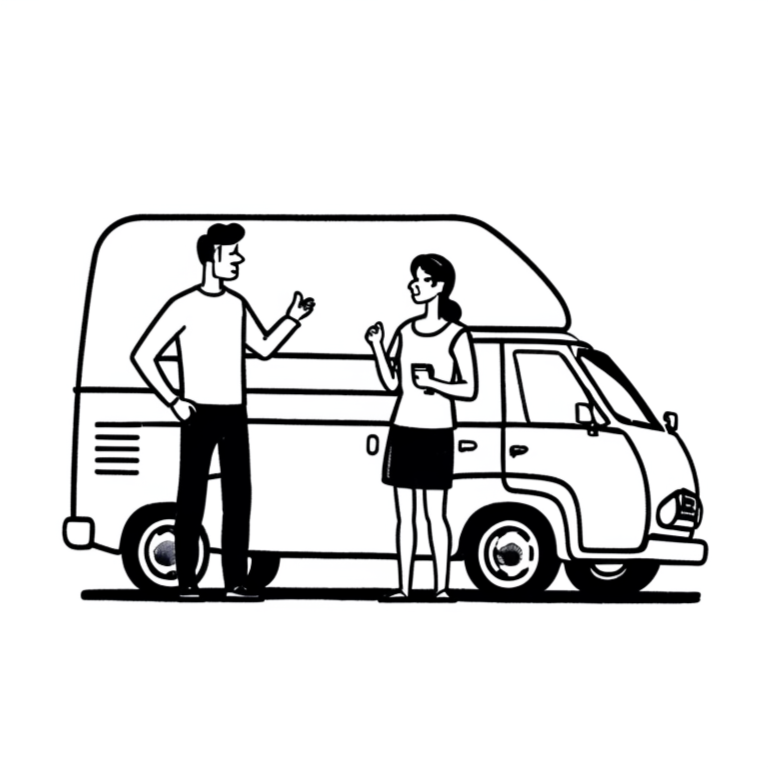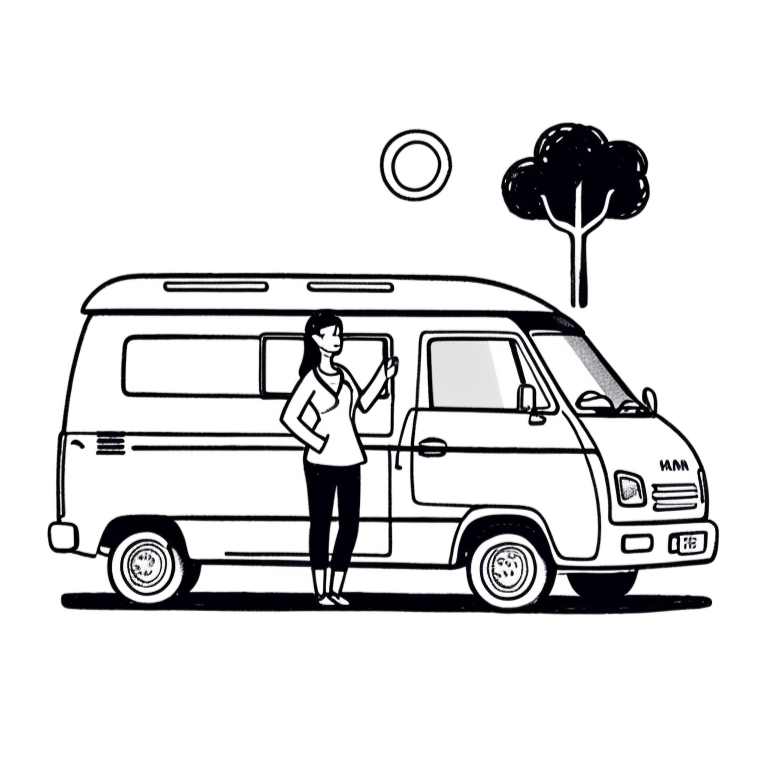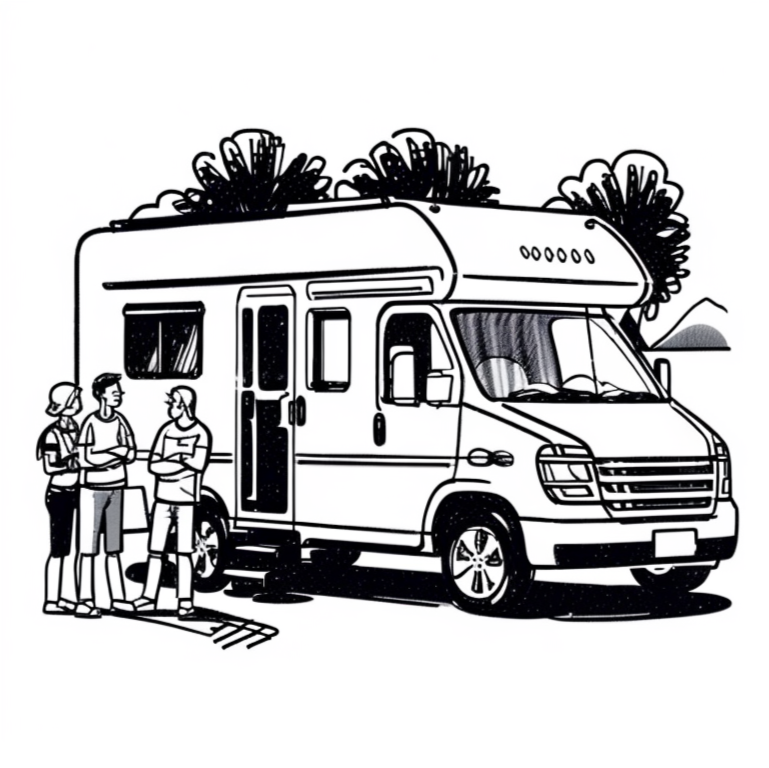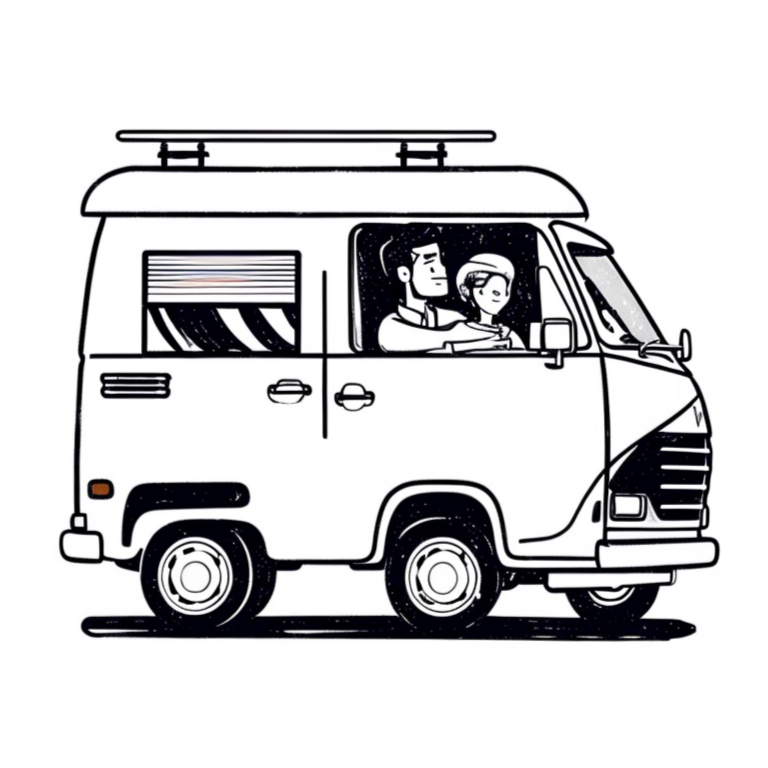Table of Contents
Section 1: Preparing for Your Campervan Test Drive
Before embarking on your campervan test drive, thorough preparation is key. By taking these necessary steps, you’ll ensure that your test drive is efficient, informative, and maximises your ability to make an informed decision.
Check Essential Documents

First and foremost, ensure you have all the essential documents in order.
This includes
- Your driver’s license
- Proof of insurance
- Any required permits for larger campervans.
Remember to double-check the seller’s paperwork too.
This step ensures you are legally ready to hit the road and eliminates any potential hiccups.
Questions to Ask the Seller

Engaging with the seller before the test drive is a valuable opportunity to gather vital information. Here are 16 key questions to ask:
- Can you provide the maintenance and service records for the campervan, including any recent repairs or upgrades?
- Are there any known issues or areas that require immediate attention or repair?
- What type of fuel does the campervan use, and what is its fuel efficiency?
- Have there been any accidents or major incidents involving the campervan?
- Can you provide details about the campervan’s mileage and its general maintenance history?
- Are there any warranties or guarantees on specific components or systems?
- Is the campervan equipped with safety features such as airbags, anti-lock brakes, or a rear-view camera?
- Can you demonstrate the functionality of key systems, including heating, cooling, and cooking appliances?
- How does the campervan handle in different driving conditions, such as highways, city streets, and off-road terrain?
- Are there any specific regulations or restrictions regarding where and how the campervan can be parked or camped?
- What are the campervan’s power sources, and can it run on both electric hookup and batteries?
- Can you provide information about the campervan’s freshwater and wastewater storage capacity?
- How does the campervan handle waste disposal, including toilet and grey water management?
- Is there an available owner’s manual or documentation for the campervan’s systems and appliances?
- Can you offer insights into the campervan’s handling and manoeuvrability, especially in tight spaces or challenging terrains?
- How much does the campervan weigh when unladen, and what is the legal maximum weight (Maximum Authorised Mass or MAM) of this campervan?
This information will help you understand the campervan’s condition and history, aiding in your evaluation.
Preliminary On-Site Inspection

Before hitting the road for your campervan test drive, conduct an on-site inspection that mirrors the thoroughness of a home inspection. Campervans, after all, are not just vehicles; they’re your mobile homes, and treating them as such is essential.
Exterior Inspection
Begin with a comprehensive exterior examination, paying attention to both the obvious and subtle details. This stage is akin to scrutinising the foundations of a house.
- Dents, Scratches, and Rust: Look for any visible dents, scratches, or signs of rust on the campervan’s exterior. Take note of any previous repair work, especially if it involves welding. [IMAGE]
- Welding History: Inspect the exterior for signs of welding history. Welding is common for modifications and repairs, and knowing where it has occurred can offer insights into the campervan’s past. Welding should be of high quality and free from any signs of hasty or amateur work.
- Underbody Examination: Crouch down and inspect the underbody of the campervan. Look for any areas that are concealed by underbody paint. This can be an indication of attempts to hide corrosion. Apply pressure to suspected corroded areas to check for structural integrity. Ensure that the chassis is free from significant corrosion that might require welding soon. [IMAGE]
- Exterior Seals and Gaskets: Assess the condition of exterior seals and gaskets, including those around doors, windows, and roof hatches. These seals are crucial in preventing leaks and maintaining a dry and comfortable interior.
Interior Inspection
Move inside the campervan for an interior inspection, paying attention to the following areas:
- Damp and Mould: Check for any signs of dampness or mould on the walls, ceilings, and around windows. This is crucial as dampness can lead to structural issues and health concerns.
- Odours: Take note of any unusual or persistent odours within the campervan. Unpleasant smells can signal hidden problems.
- Connections and Systems: Inspect the connections and fixtures for the campervan’s various systems, including sinks, gas appliances, electrical outlets, and water systems. Ensure they are secure and functioning as expected.
- Electrical Systems: Verify that all electrical systems, including lighting, appliances, outlets, and charging points, are functioning correctly. Test the campervan’s battery, inverter, and any solar panels if equipped. Ensure that all switches and controls are operational.
- Water Systems: Inspect the water supply and plumbing. Check for leaks, both freshwater and wastewater. Run the taps, flush the toilet, and assess the operation of the water pump. Verify that the water heater (if present) works as intended.
- Heating and Cooling: If the campervan has heating or air conditioning systems, test them to ensure they provide the desired level of comfort. Check for heating sources, such as gas or diesel heaters, and any cooling options like roof-mounted air conditioning units.
- Safety Features: Ensure all safety features are in working order. This includes smoke detectors, carbon monoxide detectors, fire extinguishers, and any safety locks on doors and windows. Check the condition of fire suppression systems if installed.
- Gas Systems: If the campervan uses gas for cooking or heating, inspect the gas lines, valves, and appliances. Look for any signs of gas leaks, and ensure that gas detectors are functioning correctly.
- Bathroom Facilities: If the campervan has a bathroom, inspect the toilet, shower, and any associated systems like grey-water tanks. Look for signs of wear or damage and test their functionality.
- Sleeping Arrangements: Evaluate the quality and condition of the sleeping arrangements. Check the mattresses, cushions, and bedding. Ensure that any convertible seating or sleeping areas operate smoothly.
- Storage Spaces: Examine the storage areas to ensure they are clean and free from odours, pests, or dampness. Check cabinet latches and locks to guarantee secure storage during travel.
- Interior Finish and Aesthetics: Assess the overall condition of the interior finish and aesthetics. Look for any signs of wear, damage, or needed repairs. Check for peeling wallpaper, loose fixtures, or interior design elements that may require attention.
Buyer Confidence and Communication
While conducting your thorough on-site inspection, remember that you are in control of this process. Don’t hesitate to ask questions and seek clarification if something isn’t clear. The seller should be open to discussing the campervan’s condition, history, and any modifications they’ve made. It’s your right to gain a complete understanding of what you’re potentially investing in.
If the seller appears pressuring or reluctant to address your questions, don’t be afraid to assert yourself and insist on clear answers. A trustworthy seller should be willing to provide the information you need.
Furthermore, trust your instincts. If something doesn’t feel right or you notice any inconsistencies during the inspection, take these observations seriously. While a thorough examination is crucial, your gut feeling about the transaction and the seller also plays a significant role in your decision-making process.
Remember, you’re not just buying a campervan; you’re investing in experiences and adventures. Ensuring your confidence and peace of mind during the purchase is just as important as inspecting the vehicle itself.
Setting Your Expectations
It’s essential to have clear expectations before the test drive. What features are non-negotiable for you? What aspects of the campervan are you most curious about? Understanding what you’re looking for will help you assess the campervan more effectively during the test drive.
For example, if you’re particularly interested in how the campervan handles on the motorway, make sure to include a motorway route in your test drive plan. If you want to test the campervan’s off-road capabilities, plan a route that includes rough terrain.
By clearly defining your expectations, you’ll be better prepared to assess the campervan’s suitability for your needs during the test drive.
Test Drive Companion

It can be valuable to have a companion with you during the test drive. They can provide a second perspective and help you assess various aspects of the campervan more thoroughly. If you’re considering a campervan with multiple sleeping areas or features, having someone along can help you evaluate the usability of these features.
Remember, this companion should be someone you trust and who has an interest in the campervan purchase. They can help you spot issues or aspects you might overlook during the test drive.
With these preparations in place, you’ll embark on your campervan test drive with confidence and focus, ready to assess the vehicle thoroughly and gather the information you need to make an informed decision.
Section 2: The Test Drive

Before you start
We understand that transitioning from driving a standard car to manoeuvring a campervan can be a significant step. The sheer size and added features might seem a bit overwhelming at first. But, remember, many campervan enthusiasts were once in your shoes, and with the right approach, you can confidently take the wheel of your future home on wheels.
- Build Confidence: When test-driving a campervan, it’s essential to start with confidence. The more you practice, the more comfortable you’ll become behind the wheel of your campervan.
- Leverage Assistance Systems: Modern campervans often come equipped with advanced assistance systems, including features like parking sensors, rear-view cameras, and lane-keeping assistance. Familiarizing yourself with these technological aids can significantly enhance your driving experience.
- Adopt a Gradual Approach: Take your time during the test drive. Initiate your journey in low-stress environments, such as quiet streets or spacious parking lots, before progressing to busier roadways. This gradual approach allows you to adapt to campervan driving at your own pace.
- Master Campervan Driving Essentials: When operating a campervan, it’s crucial to master certain fundamental aspects. These include executing wide turns, maintaining vigilance about low structures, navigating narrow roads with care, optimising the use of mirrors, adhering to safe following distances, managing weight distribution and downhill driving, practising reversing, respecting crosswinds, being attentive to overhangs, and understanding the nuances of parking limitations.
- Inquire and Seek Guidance: Don’t hesitate to ask the seller questions or express any concerns you may have about campervan driving. Their experience can provide valuable insights and advice to enhance your driving confidence.
- Explore Professional Instruction: If you’re new to campervan driving and seek additional guidance, consider enrolling in lessons from reputable driving schools. Some institutions offer specialized courses tailored to handling larger vehicles, providing you with valuable skills and bolstered confidence.
Remember, every campervan enthusiast started somewhere. With patience and practice, you’ll soon feel right at home behind the wheel of your campervan, ready to embark on incredible adventures. So, take a deep breath, and let’s explore the world of campervan travel together.




